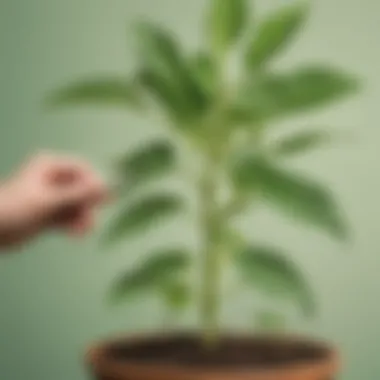Unlocking the Secrets of Plant Propagation: A Detailed Guide for Gardeners


Science Fun Facts
In the world of plants, a fascinating fact is that some species can reproduce not just through seeds but also through vegetative methods like cuttings or division. This means that with the right knowledge and techniques, one plant can give rise to multiple offspring, expanding the greenery in your garden effortlessly.
Discover the Wonders of Science
As we delve into the realm of plant propagation, we encounter various scientific concepts at play. The process of propagation involves understanding the biology of plants, including their reproductive structures and mechanisms. Educational videos and animations can further enhance our grasp of these concepts, making the learning experience both enriching and visually stimulating.
Science Quiz Time
Engaging in a quiz about plant propagation can be a fun way to test your knowledge and learn at the same time. Multiple choice questions can challenge you to think critically about the different methods of propagation and the factors that influence their success. By gamifying the learning process, quizzes can make information retention more effective and enjoyable.
Science Experiment Showcase
To truly understand the art of plant propagation, engaging in hands-on experiments can provide valuable insights. By following step-by-step instructions and utilizing the recommended materials list, you can explore the practical aspects of propagation. Safety tips and precautions ensure a secure and educational experiment, allowing you to witness botanical wonders firsthand.
Introduction to Plant Propagation
Plant propagation is an essential aspect of gardening and botany, crucial for expanding plant populations and preserving biodiversity. This article delves deep into the various methods and techniques utilized in the propagation process, offering valuable insights to horticulture enthusiasts. From seeds to cuttings, every step plays a significant role in multiplying plants and enhancing botanical knowledge. Readers will uncover the intricate secrets behind successful propagation, enriching their understanding of plant reproduction and cultivation.
Understanding Plant Propagation
The Importance of Plant Propagation
Plant propagation holds a pivotal role in sustaining plant populations and fostering genetic diversity. Its significance lies in multiplying plant species, preserving rare and endangered varieties, and ensuring the continuity of diverse ecosystems. By propagating plants, gardeners can contribute to conservation efforts and maintain the genetic richness of flora. Despite its technical nature, plant propagation is a rewarding practice that leads to the proliferation of unique plant characteristics and enhances the overall beauty of gardens and landscapes.
Basic Concepts in Plant Reproduction
Basic concepts in plant reproduction form the foundation of successful propagation endeavors. Understanding the mechanisms of pollination, fertilization, and seed development is essential for mastering the art of propagation. By grasping the fundamental principles of plant reproductive biology, growers can optimize their propagation techniques, ensuring healthy plant growth and genetic stability. Knowledge of basic plant reproduction concepts empowers individuals to make informed decisions regarding crossbreeding, hybridization, and genetic manipulation, thereby influencing the future characteristics of propagated plants.


Benefits of Propagating Plants
Preserving Rare and Endangered Species
The practice of propagating plants plays a crucial role in preserving rare and endangered species from the brink of extinction. By multiplying endangered plants through propagation methods, gardeners and conservationists can establish ex-situ conservation collections, safeguarding genetic resources for future generations. Preserving plant diversity is essential for maintaining ecological balance, enhancing ecosystem resilience, and preventing the loss of valuable genetic traits.
Customizing Plant Characteristics
Customizing plant characteristics through propagation offers growers the opportunity to create unique varieties tailored to specific preferences and environmental conditions. By selecting desired traits and propagating plants with specific characteristics, gardeners can cultivate personalized collections that reflect their aesthetic and functional preferences. Customization allows for the development of new cultivars, adaptation to changing climatic conditions, and the creation of plant compositions that effectively meet individual needs and preferences.
Methods of Plant Propagation
In the realm of plant propagation, understanding the methods is crucial to successfully multiplying plants. This section delves into various techniques used, from traditional seed propagation to advanced grafting. Methods of plant propagation play a key role in expanding botanical knowledge and enhancing gardening skills. By exploring seed propagation, cutting propagation, division, and layering, gardeners can customize plant characteristics and preserve rare species. Each method presents unique benefits and considerations, influencing the success of plant propagation endeavors.
Seed Propagation
Seed propagation forms the basis of plant reproduction, offering a cost-effective and efficient way to grow new plants. The process begins with sowing seeds in suitable conditions, providing them with essential nutrients for germination and growth. Overview of Seed Propagation details the step-by-step process of seed germination, emphasizing the importance of seed selection and optimal growing conditions. This method is popular due to its simplicity and effectiveness in producing a large number of plants. However, it requires patience and careful monitoring to ensure successful germination, making it a rewarding yet challenging choice for gardeners.
Tips for Successful Seed Germination
To achieve successful seed germination, gardeners must pay attention to critical factors like moisture, temperature, and light levels. Providing the right environment for seeds to sprout is essential for their growth and development. Tips for Successful Seed Germination offer insights into enhancing germination rates, such as scarification and stratification techniques. This aspect of seed propagation enables gardeners to experiment with different plant varieties and expand their botanical collections. While seed germination may seem straightforward, mastering the art of nurturing seeds requires dedication and precision.
Cutting Propagation
Cutting propagation is a method widely used to propagate plants with desirable traits, such as unique foliage or flower colors. Types of Stem Cuttings involve taking portions of stem from parent plants and encouraging them to develop roots in a controlled environment. This technique allows gardeners to create genetic replicas of the parent plant, preserving its characteristics in new specimens. While stem cuttings offer a reliable way to propagate plants, rooting hormones and techniques play a vital role in ensuring successful root development. By utilizing rooting hormones and applying proper techniques, gardeners can improve the viability of stem cuttings and accelerate the rooting process, leading to faster plant growth.
Rooting Hormones and Techniques
Rooting hormones stimulate root growth in stem cuttings, increasing their chances of survival and establishment as independent plants. The application of rooting hormones can enhance the rooting capacity of cuttings and promote rapid root development under favorable conditions. Understanding the role of rooting hormones and implementing appropriate techniques is essential for successful cutting propagation. While rooting hormones can expedite the propagation process, improper application may hinder root formation and overall plant growth. Gardeners must master the art of using rooting hormones judiciously to maximize the success of cutting propagation.
Division


Division offers a straightforward method of plant propagation by separating a mature plant into multiple sections for cultivation. Splitting Plants for Propagation involves dividing plant clumps or rhizomes to create new plants, each retaining the original plant's characteristics. This method is suitable for plants that naturally produce offsets or runners, allowing gardeners to expand their garden collection easily. Plants Suitable for Division explores the types of plant species that respond well to division, considering factors like growth habit and root structure. While division is a convenient way to multiply plants, choosing the right specimens and timing the process correctly are critical for ensuring successful establishment and growth.
Plants Suitable for Division
Certain plant species exhibit specific characteristics that make them ideal candidates for division, such as robust root systems and prolific clumping habits. Identifying plants suitable for division involves assessing their growth patterns and overall health to determine the best approach for propagation. This aspect of division emphasizes the importance of selecting suitable candidates for successful plant multiplication. By understanding the unique requirements of different plant species, gardeners can effectively propagate plants through division, creating new specimens that reflect the beauty and resilience of their parent plants.
Layering
Layering is a propagation technique that encourages roots to develop along stems, creating new plants from existing ones. Air Layering involves wrapping a stem section with rooting medium to promote root growth, allowing for the formation of independent plants once roots are established. This method is useful for plants with woody stems or limited branching, enabling gardeners to propagate species that are hard to root from cuttings. Simple Layering, on the other hand, entails bending a low-growing stem to the ground and covering it with soil for root formation. This approach is effective for plants that produce long, flexible stems capable of root development, providing a natural and straightforward way to multiply garden favorites.
Simple Layering
Simple Layering is a straightforward technique that utilizes the plant's natural growth pattern to create new specimens. By encouraging aerial roots to form along stems buried in soil, gardeners can produce clones of the parent plant with minimal effort. This method is suitable for species that exhibit flexibility in stem development and respond well to burying segments for root initiation. Simple Layering offers an accessible and dependable way to propagate plants that are compatible with this propagation method, making it a valuable tool for expanding botanical collections and sharing plant varieties with fellow enthusiasts.
Advanced Techniques in Plant Propagation
In the realm of plant propagation, advanced techniques play a pivotal role in expanding the boundaries of traditional methods. These sophisticated methods open up new possibilities for horticulturists and plant enthusiasts, enhancing the diversity and resilience of cultivated plant species. By delving into advanced techniques, individuals can explore innovative ways of multiplying plants that go beyond the conventional approaches, broadening their understanding and skill set in the realm of botanical reproduction. Understanding advanced techniques in plant propagation is crucial for those seeking to deepen their knowledge and expertise in this specialized field, offering a glimpse into the intricate processes that drive successful plant multiplication.
Types of Grafting Techniques
When it comes to advanced plant propagation, the practice of grafting techniques stands out as a time-honored method with significant benefits and applications. Grafting involves joining different plant tissues to create a new organism that combines the desirable traits of the parent plants. This technique allows growers to propagate plants with specific characteristics, such as improved disease resistance or unique fruiting qualities, enhancing the overall quality of plant populations. One key characteristic of grafting techniques is the precision required to ensure successful fusion between the rootstock and scion, leading to a robust and vigorous plant establishment. The art of grafting techniques offers a pathway to harness genetic diversity and create novel plant varieties tailored to meet specific horticultural objectives, making it a valuable choice for individuals looking to optimize plant productivity and diversity.
Selecting Compatible Plant Varieties
Another fundamental aspect of advanced plant propagation is the careful selection of compatible plant varieties for grafting purposes. The success of grafting techniques hinges on choosing plant species that exhibit genetic compatibility, ensuring a harmonious union between the rootstock and scion. By selecting compatible plant varieties, growers can increase the likelihood of successful graft formation and long-term plant survival, achieving the desired outcomes in terms of plant vigor and performance. The key characteristic of selecting compatible plant varieties lies in the meticulous assessment of plant genetic traits and physiological compatibility, a process that requires attention to detail and expertise. This meticulous selection process sets the foundation for successful grafting outcomes, offering growers the opportunity to create resilient and high-performing plant hybrids that embody the best qualities of the parent species. Understanding the nuances of selecting compatible plant varieties is essential for maximizing the potential of grafting techniques and achieving outstanding results in plant propagation endeavors.
Factors Influencing Plant Propagation Success
Factors influencing plant propagation success are crucial elements in the art of multiplying plants. Understanding and optimizing these factors can significantly enhance the overall success rate of propagation endeavors. By delving into the environmental conditions and timing considerations, gardeners can maximize the growth and development of propagated plants.


Environmental Conditions
Environmental conditions play a pivotal role in plant propagation success. When dissecting the key elements of environmental conditions, factors such as light, temperature, humidity, soil quality, and water availability come into play. These variables directly impact the growth, health, and resilience of propagated plants.
Light, Temperature, and Humidity Requirements
Light, temperature, and humidity requirements are essential factors in plant propagation. Light influences photosynthesis and overall plant growth, while temperature and humidity levels determine the plant's metabolic functions. Understanding the specific light intensity, optimal temperature range, and humidity levels required for different plant species is critical for successful propagation efforts.
Soil and Water Considerations
Soil and water considerations are equally significant in fostering plant propagation success. The composition of the soil affects nutrient availability and root development, influencing the plant's overall health. Adequate water supply and proper drainage are crucial for maintaining the plant's hydration levels and avoiding waterlogging, ensuring optimal conditions for growth and propagation activities.
Timing and Seasonality
The timing and seasonality of propagation activities play a pivotal role in determining the success of plant multiplication efforts. Choosing the ideal times for different propagation methods and adapting to seasonal changes are essential strategies for maximizing the propagation success rate.
Ideal Times for Different Propagation Methods
Selecting the ideal times for different propagation methods is crucial for ensuring successful plant multiplication. Understanding the specific growth cycles and reproductive seasons of various plant species allows gardeners to capitalize on the plants' natural ability to thrive and propagate. By aligning propagation efforts with the plants' biological rhythms, optimal outcomes can be achieved.
Adapting to Seasonal Changes
Adapting to seasonal changes is a key aspect of efficient plant propagation. Plants respond differently to varying environmental conditions throughout the seasons, necessitating adaptive strategies for successful propagation. By adjusting cultivation practices, timing propagation activities, and providing necessary environmental support, gardeners can navigate seasonal fluctuations and optimize plant growth and propagation rates.
Troubleshooting Common Propagation Issues
Troubleshooting common propagation issues is a vital aspect covered in this expansive guide on plant propagation. In the intricate world of gardening and plant care, challenges can arise, hindering the propagation process. Addressing and resolving these issues is key to successful plant multiplication. By comprehensively discussing troubleshooting techniques, readers can enhance their problem-solving skills, ensuring healthy plant growth and propagation success.
Preventing and Addressing Plant Propagation Problems
Pest and Disease Management
Pest and disease management plays a pivotal role in the overarching goal of successful plant propagation. In the realm of gardening, pests and diseases can wreak havoc on plants, impeding their growth and propagation potential. Effectively managing pests and diseases is imperative for maintaining plant health and ensuring optimal propagation outcomes. This section delves into the nuances of identifying and addressing common pests and diseases, emphasizing the importance of proactive management strategies. By implementing proper pest and disease control measures, gardeners can protect their plants and optimize propagation efforts.
Nutritional Deficiencies
Nutritional deficiencies are another critical factor influencing plant propagation success. Adequate access to essential nutrients is paramount for healthy plant growth and development. Nutrient-deficient plants are more susceptible to diseases and may exhibit stunted growth or discoloration. Recognizing and addressing nutritional deficiencies is instrumental in fostering robust plants capable of successful propagation. This section sheds light on identifying common signs of nutrient deficiencies, discussing the impact of various nutrients on plant health. By understanding and rectifying nutritional imbalances, gardeners can cultivate thriving plants primed for successful propagation.







